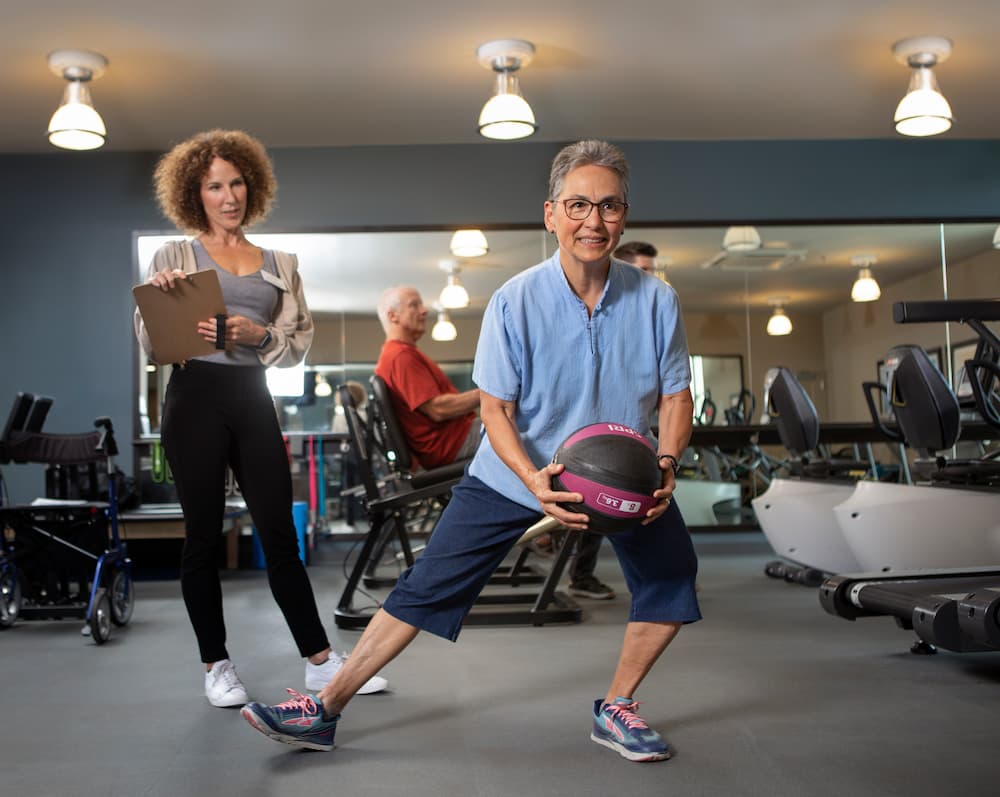Using the age of 65 to define the senior population is in many ways an arbitrary choice. Ask many adults who’ve celebrated that milestone birthday, and they’ll tell you they certainly don’t feel like a senior citizen.
Still, over the decades, our bodies undergo changes no matter how much we try to fend off the effects of time. Some of these changes mean the fitness activities we’ve engaged in are no longer recommended as senior workouts. But there are plenty of safe options that can be incorporated into an exercise program for seniors—as you’ll discover when you keep reading.
Staying Active Is Vital for Older Adults
While engaging in physical activity is important for people of all ages, being active is especially crucial to older adults who want to remain as healthy and independent as possible, for as long as possible.
Not only can a physical exercise routine help prevent or alleviate the symptoms of heart disease, high blood pressure, depression and diabetes, it can also help with balance, muscle strength, bone density, mood and sleep quality.
Compared with their sedentary peers, older adults who are physically active tend to:
- Feel more energetic
- Enjoy a more consistent positive outlook
- Benefit from improved cognitive health
- Experience a higher quality of life
- Be more likely to perform activities of daily living (such as eating, dressing, bathing and getting in and out of bed or a chair) with little or no assistance
- Have a lower risk of injury from falling
Senior Exercises Should Emphasize Safety First
Some older adults have never stepped foot inside a gym or even given exercise much thought. Others may have been physically active in their younger years but shifted their priorities as the responsibilities of raising a family or advancing their career required more time and energy.
If you’re new to exercise or looking to gradually get back into it after being sedentary for a while, it’s always a good idea to talk with your physician before getting started on a new routine. This is also true if you have any chronic illnesses or physical limitations such as mobility issues.
Regardless of your level of fitness, think about consulting a fitness professional or doing some online research about specific activities or exercises you’re planning to do. A simple search on the internet using a phrase such as “safe senior exercises” is a good place to begin—as long as you rely on trustworthy sources.
Many types of exercises suggested specifically for older adults address multiple desired outcomes, such as improved balance, strength, flexibility and endurance. Some low-impact exercises, such as water aerobics and chair yoga, are often recommended for those who have achy joints from arthritis or other health conditions.
Remember, any senior exercise program should place your safety above all else!
No Need To Join a Gym
The thought of walking into a fitness facility might feel intimidating—unless it’s one like our fitness center at Heron’s Key, where everyone except the fitness specialists is in your age group.
If you prefer some privacy as you begin your physical activity routine, you can go online and find a wide array of exercises for seniors at home, many with videos you can watch to make sure you’re doing them properly.
These basic exercises will help you get started.
Bridge
You can do this exercise while lying on a mat on the floor, on a carpeted floor or on your bed. It builds strength in the muscles of your back body while also stretching the muscles in the front of your body. It’s an especially good exercise for anyone who sits a lot.
- Lie on the floor, face up, with your knees bent and your feet flat on the floor.
- Place your arms at your sides, palms facing down.
- Lift your hips up into the air so your knees, hips and shoulders are in a straight line.
- Squeeze the muscles in your buttocks and hold this position for several seconds.
- Slowly, and with control, lower your hips back to the floor.
- Repeat several times.
- As you get stronger, you can hold the pose longer and do more repetitions. Eventually, you can try lifting one leg straight up toward the ceiling as your hips are raised and then alternate with the other leg.
- Be sure to relax your neck while doing this exercise.
Wall Push-Ups
Push-ups use your body weight to build strength in your chest, arms, shoulders and core.
- Stand straight, facing a wall, about a foot away from the wall.
- Place your hands on the wall at shoulder height and a little more than shoulder-width apart.
- Walk your feet back away from the wall, keeping your body in a straight line.
- Tighten your core muscles and your buttocks.
- Bend your elbows and bring your chest toward the wall.
- Straighten your elbows and take your chest back away from the wall.
- Repeat several times.
- As you get stronger, you can do more repetitions and make the exercise more challenging by stepping farther away from the wall.
You can do regular push-ups on the floor if you prefer, making them less strenuous by keeping your knees on the ground while you raise and lower your upper body. You can also do chair push-ups, standing behind a sturdy chair and pushing down on the back of the chair with your hands while you raise and lower your body toward the back of the chair.
Bird Dog
This exercise helps improve balance and stability by creating a stronger core. It works muscles along your spine and in your upper back and shoulders, as well as your abdominal muscles, glutes (in your buttocks) and hamstrings.
- On a mat or carpeted floor, get onto your hands and knees. Be sure your hands are directly beneath your shoulders and your knees are directly under your hips.
- Lift and extend one leg behind you while reaching the opposite arm out in front of you. You should form a straight line from the tips of your fingers on the outstretched arm to your toes on the leg stretched out behind you. Keep your eyes on the floor below you.
- Return your hand and knee to the floor so you’re in the same position in which you started.
- Repeat on the opposite side.
- Alternate sides several times.
- As you get stronger and steadier, you can incorporate crunches by bringing your elbow to meet your knee (while gently arching your back) and then stretching your arm and leg out again before returning your hand and knee to the ground.
Knee-to-Chest Stretch
If you have tension in your lower back and hips, this stretch can help alleviate that. It can also improve your flexibility and range of motion in your hips and hamstrings.
- Lie on the floor (on a mat or carpet) with your knees bent and feet flat on the ground.
- Clasp your hands around one knee and bring it in toward your chest.
- While keeping your lower back pressed to the floor, hold your knee to your chest for 15 to 30 seconds.
- Relax and return to your starting position.
- Do the same movement with the other knee.
- Do several repetitions on each side.
If you have any discomfort in your knees, you can clasp your hands around the back of your thigh instead of around your knee. Also, it may feel better for your back if you keep the opposite leg flat on the floor (instead of bent at the knee) while bringing your knee toward your chest.
Single Leg Balance
As you start doing this exercise, you may want to stand with one hand against the wall or hold on to the back of a sturdy chair for support. As your balance improves, you may not need any support.
- Stand with your feet hip-width apart, hands on your hips.
- Lift one foot off the floor, bending your leg at the knee, and raise your foot behind you while keeping your knees even.
- Hold for 10 to 30 seconds.
- Lower your foot to the ground and repeat on the opposite side.
- Do several repetitions on each leg.
How Often Should You Exercise?
The Centers for Disease Control and Prevention (CDC) recommends that seniors engage in activities of moderate intensity for at least 150 minutes a week. Brisk walking, lively dancing, swimming and bike riding are examples of moderate-intensity activities. You can aim for 30 minutes per day, five days a week, or break it up into shorter blocks of time.
Older adults should also participate in muscle-strengthening activities at least twice a week and balance activities on most days, according to the CDC.
Physical Activity Is Part of Our Holistic Approach to Wellness
If you’d like to learn more about how residents at Heron’s Key enjoy staying active, we invite you to come have a look around. We’ll show you our beautiful community and tell you all about the amenities we offer, including our fitness center.
While you’re here, you can talk with some of our residents to find out what they like most about living at Heron’s Key. To arrange a visit, contact us or call (877) 892-7129.








